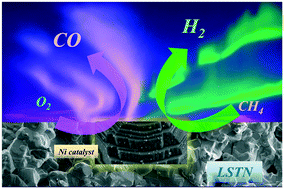Studies of exsolution and catalytic activity of metal nanocatalysts from parent perovskite
Abstract
The synthesis of metal nanocatalysts exsolved from A-site deficient lanthanum strontium titanate (La0.4Sr0.4)(NixTi1−x)O3−γ (LST, x = 0, LSTN, x = 0.06, 0.25 and 0.5) perovskites and their catalytic properties are presented. These perovskites were doped in the B-site with varying amounts of nickel to obtain a stable perovskite structure (LSTN) theoretically. The exsolution of metal was investigated under different conditions to control particle nucleation. Results on the catalytic activity of the metal-exsolved material in repetitive redox cycles showed that the LSTN materials catalyze the production of H2 and CO in the half-cycle of reduction and oxidation, respectively, while the LST material could not. The macroscopic result obtained was complemented by in situ infrared studies at a molecular level. Our studies indicated that the LSTN materials are promising solid oxygen carriers for the conversion of methane in a novel process with highly efficient gas separation. The insights developed here were beneficial for the design of other materials capable of exsolution and for the applications of these materials ranging from catalysis, fuel cells, and beyond.



 Please wait while we load your content...
Please wait while we load your content...